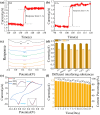Copper Nanoclusters Anchored on Crumpled N-Doped MXene for Ultra-Sensitive Electrochemical Sensing
- PMID: 40285194
- PMCID: PMC12031129
- DOI: 10.3390/s25082508
Copper Nanoclusters Anchored on Crumpled N-Doped MXene for Ultra-Sensitive Electrochemical Sensing
Abstract
Simultaneous detection of dopamine (DA) and uric acid (UA) is essential for diagnosing neurological and metabolic diseases but hindered by overlapping electrochemical signals. We present an ultrasensitive electrochemical sensor using copper nanoclusters anchored on nitrogen-doped crumpled Ti3C2Tx MXene (Cu-N/Ti3C2Tx). The engineered 3D crumpled architecture prevents MXene restacking, exposes active sites, and enhances ion transport, while Cu nanoclusters boost electrocatalytic activity via accelerated electron transfer. Structural analyses confirm uniform Cu dispersion (3.0 wt%), Ti-N bonding, and strain-induced wrinkles, synergistically improving conductivity. The sensor achieves exceptional sensitivity (1958.3 and 1152.7 μA·mM-1·cm-2 for DA/UA), ultralow detection limits (0.058 and 0.099 μM for DA/UA), rapid response (<1.5 s), and interference resistance (e.g., ascorbic acid). Differential pulse voltammetry enables independent linear detection ranges (DA: 2-60 μM; UA: 5-100 μM) in biofluids, with 94.4% stability retention over 7 days. The designed sensor exhibits excellent capabilities for DA and UA detection. This work provides a novel design strategy for developing high-performance electrochemical sensors.
Keywords: Cu nanoclusters; MXene; crumpled structure; dopamine; uric acid.
Conflict of interest statement
The authors declare no conflict of interest.
Figures





Similar articles
-
Lithium cobalt phosphate electrode for the simultaneous determination of ascorbic acid, dopamine, and serum uric acid by differential pulse voltammetry.Mikrochim Acta. 2021 May 15;188(6):190. doi: 10.1007/s00604-021-04839-5. Mikrochim Acta. 2021. PMID: 33991256
-
Simultaneous Recognition of Dopamine and Uric Acid in the Presence of Ascorbic Acid via an Intercalated MXene/PPy Nanocomposite.Sensors (Basel). 2021 Apr 28;21(9):3069. doi: 10.3390/s21093069. Sensors (Basel). 2021. PMID: 33924954 Free PMC article.
-
Simultaneous and sensitive determination of ascorbic acid, dopamine and uric acid via an electrochemical sensor based on PVP-graphene composite.J Nanobiotechnology. 2020 Aug 10;18(1):112. doi: 10.1186/s12951-020-00672-9. J Nanobiotechnology. 2020. PMID: 32778119 Free PMC article.
-
Simultaneous Electrochemical Detection of Dopamine and Uric Acid via Au@Cu-Metal Organic Framework.Chempluschem. 2024 May;89(5):e202300686. doi: 10.1002/cplu.202300686. Epub 2024 Feb 8. Chempluschem. 2024. PMID: 38261267
-
Sensitive sensing platform based on Co, Mo doped electrospun nanofibers for simultaneous electrochemical detection of dopamine and uric acid.Talanta. 2024 May 1;271:125674. doi: 10.1016/j.talanta.2024.125674. Epub 2024 Jan 20. Talanta. 2024. PMID: 38245960
References
-
- Sriram B., Kogularasu S., Wang S.-F., Sheu J.-K. Deep Eutectic Solvent-Mediated Synthesis of Spinel Zinc Chromite Nanoparticles: A Simple Label-Free Electrochemical Sensor for Dopamine and Ascorbic Acid. ACS Appl. Nano Mater. 2023;6:17593–17602. doi: 10.1021/acsanm.3c02775. - DOI
-
- Shukla R.P., Aroosh M., Matzafi A., Ben-Yoav H. Partially Functional Electrode Modifications for Rapid Detection of Dopamine in Urine. Adv. Funct. Mater. 2021;31:2004146. doi: 10.1002/adfm.202004146. - DOI
-
- Shi Z., Wu X., Zou Z., Yu L., Hu F., Li Y., Guo C., Li C.M. Screen-Printed Analytical Strip Constructed with Bacteria-Templated Porous N-Doped Carbon Nanorods/Au Nanoparticles for Sensitive Electrochemical Detection of Dopamine Molecules. Biosens. Bioelectron. 2021;186:113303. doi: 10.1016/j.bios.2021.113303. - DOI - PubMed
-
- Feng J., Li Q., Cai J., Yang T., Chen J., Hou X. Electrochemical Detection Mechanism of Dopamine and Uric Acid on Titanium Nitride-Reduced Graphene Oxide Composite with and without Ascorbic Acid. Sens. Actuators B Chem. 2019;298:126872. doi: 10.1016/j.snb.2019.126872. - DOI
Grants and funding
LinkOut - more resources
Full Text Sources

